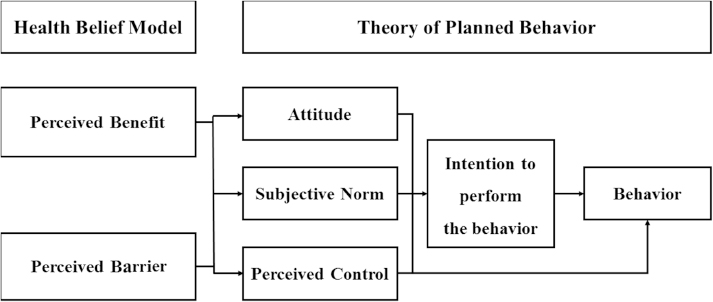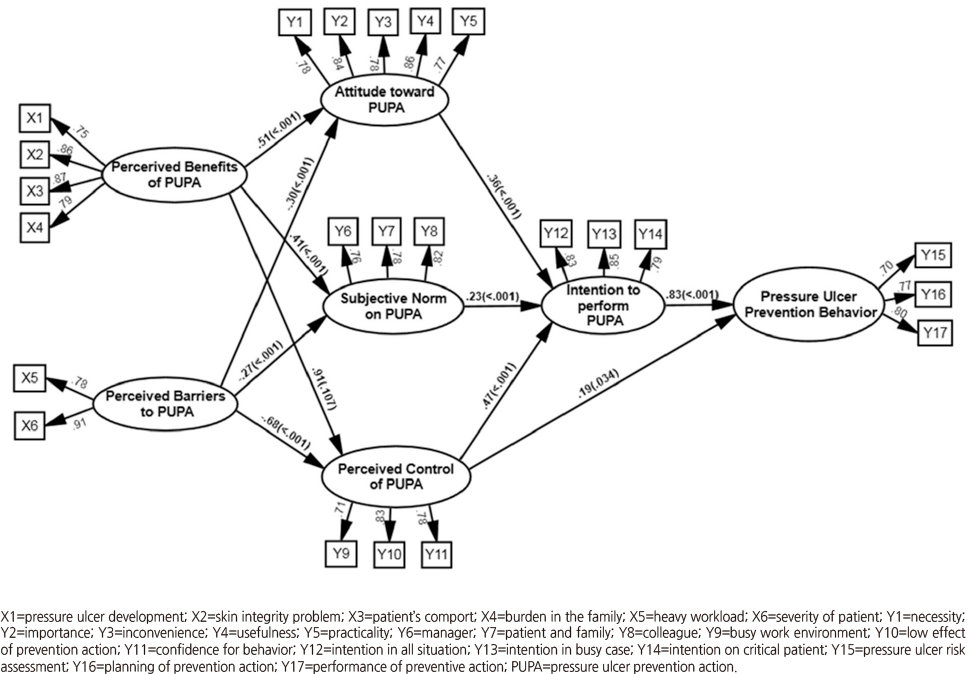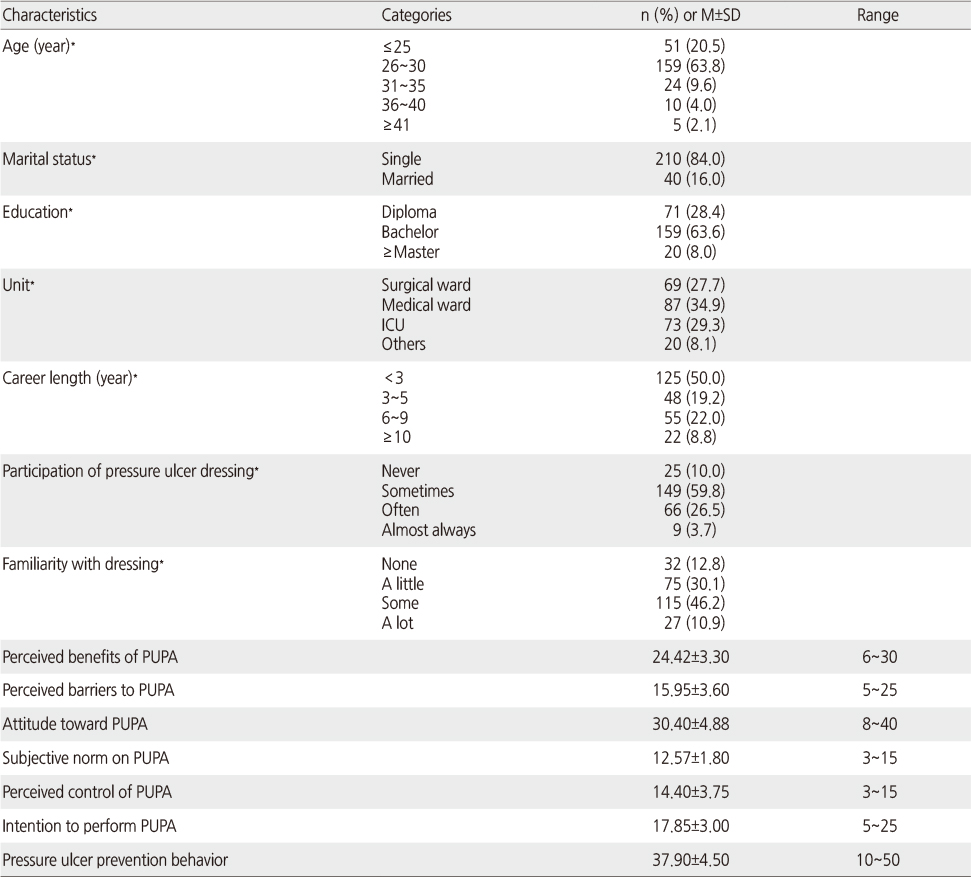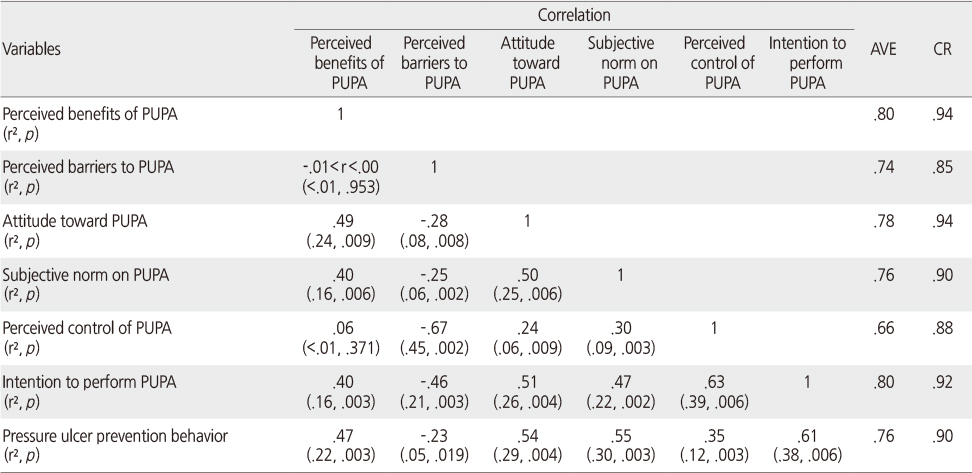Articles
- Page Path
- HOME > J Korean Acad Nurs > Volume 46(4); 2016 > Article
-
Original Article
- A Structural Equation Model of Pressure Ulcer Prevention Action in Clinical Nurses
- Sook Ja Lee, Ok Kyoung Park, Mi Yeon Park
-
Journal of Korean Academy of Nursing 2016;46(4):572-582.
DOI: https://doi.org/10.4040/jkan.2016.46.4.572
Published online: August 31, 2016
1College of Nursing, Korea University, Seoul, Korea.
2Nursing Service Department, Korea University Ansan Hospital, Ansan, Korea.
- Address reprint requests to : Park, Ok Kyoung. Nursing Service Department, Korea University Ansan Hospital, 123, Jeokgeum-ro, Danwon-gu, Ansan-si, Gyeonggi-do, 15355, Korea. Tel: +82-31-412-5477, Fax: +82-31-412-5414, ok-sk81@korea.ac.kr
© 2016 Korean Society of Nursing Science
This is an Open Access article distributed under the terms of the Creative Commons Attribution NoDerivs License. (http://creativecommons.org/licenses/by-nd/4.0/) If the original work is properly cited and retained without any modification or reproduction, it can be used and re-distributed in any format and medium.
Figure & Data
REFERENCES
Citations

- Knowledge and Visual Differentiation Ability of the Pressure Injury Classification System and Incontinence-Associated Dermatitis among Hospital Nurses: A Descriptive Study
Seungmi Park, Eun Jung Kim, Son Ja Lee, Eun Jeong Kim, Ji Yeon Lee, Jung Eun Hong
Healthcare.2024; 12(2): 145. CrossRef - A Study of Pandemic Prevention Health Behavior in Adults
Mihyeon Seong, Kyungeui Bae
International Journal of Environmental Research and Public Health.2022; 19(13): 8181. CrossRef - Factors associated with preventive behaviors for COVID-19 among adolescents in South Korea
Sunhee Park, Sumi Oh
Journal of Pediatric Nursing.2022; 62: e69. CrossRef - Effects of Attitude, Barriers/Facilitators, and Visual Differentiation on Oral Mucosa Pressure Ulcer Prevention Performance Intention
Min Kyeong Kang, Myoung Soo Kim
Healthcare.2021; 9(1): 76. CrossRef - Patient Safety Management Activities of Clinical Nurse: A Modified Theory of Planned Behavior
Nam Yi Kim, Sun Young Jeong
Journal of Korean Academy of Nursing Administration.2019; 25(5): 384. CrossRef - Canonical Correlation between Knowledge-Barriers/Facilitators for Pressure Ulcer Prevention Nursing Variables and Attitude-Performance Variables
Myoung Soo Kim, Jung Mi Ryu
Journal of Health Informatics and Statistics.2019; 44(3): 227. CrossRef - Development of the Unit Specialist-led Pressure Ulcer Nursing Algorithm
Yuna Noh, Jia Lee
Korean Journal of Adult Nursing.2019; 31(4): 365. CrossRef - Using the theory of planned behaviour to predict nurse's intention to undertake dual practice in China: A multicentre survey
Xiaoling Bai, Anni Wang, Virginia Plummer, Louisa Lam, Wendy Cross, Ziyao Guan, Xin Hu, Mei Sun, Siyuan Tang
Journal of Clinical Nursing.2019; 28(11-12): 2101. CrossRef - A Structural Equation Modeling of Prostate Cancer Screening Intention
Ji Hye Jeong, Nam Hee Park
Journal of Korean Academy of Community Health Nursing.2019; 30(4): 471. CrossRef


Figure 1
Figure 2
General Characteristics and Descriptive Statistics of Observed Variables
*Except for non–response; PUPA=pressure ulcer prevention action.
Correlation Relations between Variables and Verification of Construct Validity
PUPA=Pressure ulcer prevention action; AVE=Average Variance Extracted; CR=Construct Reliability;r=correlation estimate.
Standardized Estimates, C.R., SMC, Standardized Direct, Indirect, and Total Effects for the Hypothetical Model
C.R.=Critical ratio; SMC=Squared multiple correlation; β=Standardized regression coefficients; PUPA=Pressure ulcer prevention action.
*Except for non–response; PUPA=pressure ulcer prevention action.
PUPA=Pressure ulcer prevention action; AVE=Average Variance Extracted; CR=Construct Reliability;r=correlation estimate.
C.R.=Critical ratio; SMC=Squared multiple correlation; β=Standardized regression coefficients; PUPA=Pressure ulcer prevention action.
 KSNS
KSNS
 E-SUBMISSION
E-SUBMISSION





 Cite
Cite

